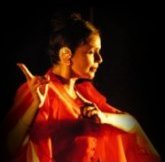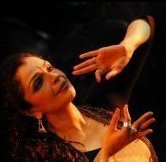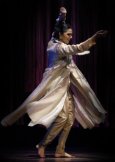| Responses
to Dance and Discussion on the Divine Feminine titled HER and BLISS...in
chapters, by Anita Ratnam for Jnanapravaha, Mumbai on October 29 &
30, 2010 
She successfully
attempted to connect the ancient goddesses with the contemporary.
In a solo dance narrative, the artiste loses track of time, but in her
case, she had transcended time and was still in touch with the contemporary
goddess. The contemporary goddess is the outcome of politics of religion,
media-management and commercialization of beliefs and practices. Taking
note of these facets, Dr. Ratnam skillfully maneuvered this journey of
the feminine from the ancient to the contemporary.
Boundlessness
of the dance within the boundary of the stage is a stark antithesis of
her performance, which heightens dance not just as an art form but as a
medium of communicating self-expression, ideas and imageries. A contemporary
classical artist like Dr. Ratnam, seamlessly integrates the theoretical
framework of an academic with the music, movements and expressions. The
two-day seminar at Jnanapravaha (the space for cultural enquiry) was so
aesthetically carved out that the costume changes using contrasts of vibrant
and subtle colours enabled the audience to get the feel of the dichotomy
between the transcendental and mundane. Such vibrancy is much-needed
in the Indian academic field to communicate complex concepts and ideas
in a holistic manner. To enrich and
contemporize Indian knowledge traditions, it is essential to undertake
an integrated approach combining the three Ps - Philosophy, Poetics and
Performing Arts. The efforts of Dr.Anita Ratnam on these lines were
path-breaking and exemplary.
- Sacred
Feminine: Ancient to Contemporary by Dr. Madhavi Narsalay
(Assistant Professor,
Dept. of Sanskrit, University of Mumbai) 
Two evenings,
over 5 magical hours, saw Dr. Anita Ratnam, an internationally acclaimed
neo-classical and contemporary dance-actor, approximate the "ultimate and
impossible." To capture the essence of the Divine Feminine, to communicate
Her Infinity, to portray Her myriad forms and moods, requires rare courage,
penetrating insight and intense devotion. Anita combined these qualities
with her profound knowledge of not only the movement arts, but also the
literary and the aural. Weaving texts, traditions, legends, histories with
canonical music and verse, she took the audience on a captivating journey
of evolution and involution. Beginning with the exploration of space through
the Sri Chakra and ending with Tara in whom all dissolves, she systematically
narrated multiplicity through Lalita Sahasranama, and individuality through
iconic Mahalakshmi, Saraswati, Annapoorna. The historic and poetic Sri
Andal and Meera Bai were painted through Shringara and mythic Yashoda through
Vatsalya. Awesome possession and uncontrollable valour were delineated
through Amman and Minakshi. Liquid Goddesses – Ganga, Yamuna, Saraswati
were objects of poetic veneration. The unexpected satirical rendition of
the modern and contemporary woman was the culmination of another trajectory,
circling into completion the attempt to connect with the Goddess. This
performance – discussion was an unparalleled method of understanding "HER
and BLISS" through chapters.
- Dr. Rashmi
Poddar
(Art historian
and cultural curator)

The 2-evening
performance-lecture by Anita Ratnam at Jnanapravaha, "HER and bliss...
in chapters" made many journeys simultaneously. The structure of myths,
motifs, symbols and performing art came together clearly and strongly -
bringing out the role of visual and performing arts in the way we understand
our myths and symbols, our history and world. When we study myths and motifs
through visual arts, there is a way in which we assume the journey from
idea to image, the same journey made through dance and movements highlights
and throws to the fore some very different and interesting aspects of the
journeys between idea and image, back-and-forth. This journey gets further
emphasised as Ratnam explains her own experiments and personal engagements
with movement, costume, props and choreography. One thing that I personally
enjoyed was to see choreography and motifs carving out space as image,
where clearly the space as image even extends beyond the conventions of
three dimensions, extending into expressions and memories of stories, spaces,
places, themes and ideas.
- Kaiwan Mehta
(Architect,
and Researcher in the field of Visual Culture)
Home | About | Events | Active Repertoire |
Activities | Press | Contact | Site map
|









